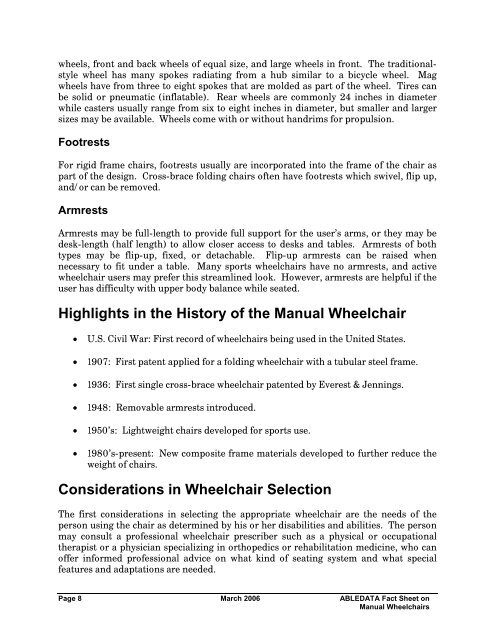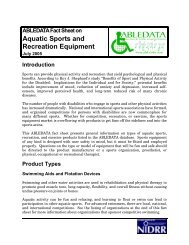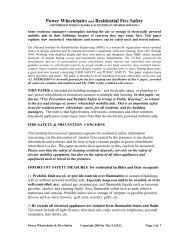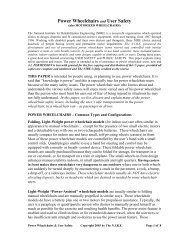ABLEDATA Fact Sheet On Manual Wheelchairs
ABLEDATA Fact Sheet On Manual Wheelchairs
ABLEDATA Fact Sheet On Manual Wheelchairs
You also want an ePaper? Increase the reach of your titles
YUMPU automatically turns print PDFs into web optimized ePapers that Google loves.
wheels, front and back wheels of equal size, and large wheels in front. The traditionalstyle<br />
wheel has many spokes radiating from a hub similar to a bicycle wheel. Mag<br />
wheels have from three to eight spokes that are molded as part of the wheel. Tires can<br />
be solid or pneumatic (inflatable). Rear wheels are commonly 24 inches in diameter<br />
while casters usually range from six to eight inches in diameter, but smaller and larger<br />
sizes may be available. Wheels come with or without handrims for propulsion.<br />
Footrests<br />
For rigid frame chairs, footrests usually are incorporated into the frame of the chair as<br />
part of the design. Cross-brace folding chairs often have footrests which swivel, flip up,<br />
and/or can be removed.<br />
Armrests<br />
Armrests may be full-length to provide full support for the user’s arms, or they may be<br />
desk-length (half length) to allow closer access to desks and tables. Armrests of both<br />
types may be flip-up, fixed, or detachable. Flip-up armrests can be raised when<br />
necessary to fit under a table. Many sports wheelchairs have no armrests, and active<br />
wheelchair users may prefer this streamlined look. However, armrests are helpful if the<br />
user has difficulty with upper body balance while seated.<br />
Highlights in the History of the <strong>Manual</strong> Wheelchair<br />
• U.S. Civil War: First record of wheelchairs being used in the United States.<br />
• 1907: First patent applied for a folding wheelchair with a tubular steel frame.<br />
• 1936: First single cross-brace wheelchair patented by Everest & Jennings.<br />
• 1948: Removable armrests introduced.<br />
• 1950’s: Lightweight chairs developed for sports use.<br />
• 1980’s-present: New composite frame materials developed to further reduce the<br />
weight of chairs.<br />
Considerations in Wheelchair Selection<br />
The first considerations in selecting the appropriate wheelchair are the needs of the<br />
person using the chair as determined by his or her disabilities and abilities. The person<br />
may consult a professional wheelchair prescriber such as a physical or occupational<br />
therapist or a physician specializing in orthopedics or rehabilitation medicine, who can<br />
offer informed professional advice on what kind of seating system and what special<br />
features and adaptations are needed.<br />
Page 8 March 2006 <strong>ABLEDATA</strong> <strong>Fact</strong> <strong>Sheet</strong> on<br />
<strong>Manual</strong> <strong>Wheelchairs</strong>







